Application of emergency broadcasting in coal mines
Time:2022-04-28
Views:271
1、 Overview
In the event of a sudden disaster in a mine, time is life. Command and dispatch personnel may not be able to notify on-site personnel in a short period of time through telephone or wireless mobile phones due to the blockage of the telephone communication system. Delays may be caused by on-site personnel being unable to communicate or not answering calls in a timely manner, or serious errors may be caused by communication errors. Due to the limited scope and slow speed of information dissemination, the favorable opportunity for risk avoidance has been lost.
According to the notice from the State Administration of Work Safety and the State Administration of Coal Mine Safety on the construction and improvement of the "six major systems" for underground safety avoidance in coal mines, coal mining enterprises should actively promote the use of underground emergency broadcasting and communication systems. When a dangerous situation occurs, it is necessary to promptly notify underground personnel to evacuate. The emergency broadcasting and communication system plays an important role in the daily production and life of mines. Under normal circumstances, broadcasting signals release news, internal information, daily routine signals, provide background music, as well as paging and forcibly inserting emergency broadcasts of catastrophic accidents through the mine information network. It is an indispensable component of mine safety production.
To ensure that coal mining enterprises can notify underground workers in the fastest and simplest way when encountering emergencies, take corresponding safety measures, and guide relevant personnel to evacuate urgently, achieving timely and effective emergency rescue. Our company has developed a digital, IP based, SIP based, video based, and intelligent emergency rescue command system for coal mines, taking into account the current situation and development direction of coal mine emergency broadcasting communication systems and video surveillance. We use technologies such as digital, microcontroller encoding and decoding, and embedded software. This system integrates safety broadcasting, video monitoring, dispatch and command, safety monitoring, and public voice. It is a new generation of digital voice system and has been recognized by many mining industries.
At present, the expansion terminals in the mining industry are generally dominated by analog telephone or network broadcasting, achieving on-site expansion and broadcasting. The new generation of mine emergency broadcasting system can achieve remote video monitoring, visual communication, and broadcasting functions underground, and is currently an alternative product to the mine emergency broadcasting communication system.
The mining broadcasting system not only has the integration communication of remote broadcasting, remote video monitoring, expanded telephone access, emergency calling, visual intercom, wired telephone, wireless telephone and other systems, but also has the advantages of long transmission distance, large installation range, good anti-interference, strong control function, etc. It can be integrated with coal mine safety monitoring system, mining industry environmental monitoring system, precise location system, video monitoring system, etc.
2. Analysis of the Current Situation of Mining Emergency Broadcasting and Communication System
The collection, transmission, and storage of audio signals in early mining emergency broadcasting communication systems were all analog, using constant voltage broadcasting for transmission and responding to all calls. However, since digital emergency broadcasting systems have not yet emerged, data transmission and regional broadcasting cannot be carried out through the network. The constant pressure emergency broadcasting communication system has good real-time performance, but it has disadvantages such as occupying a lot of line resources, easy distortion of audio signals during transmission, and small communication range.
The proposal of "digital mines" has gradually applied digital voice communication to coal mine safety production. Currently, the mine emergency broadcasting communication system is in the stage of mixed application of analog and digital. Digital broadcasting has the advantages of pure sound quality, strong anti-interference ability, large coverage area, and complete functions. Its application prospects are broader than those of constant pressure broadcasting. More and more mining enterprises are starting to use digital voice communication technology to replace analog voice communication technology. Especially with the rise of VOIP technology, it has driven the industrial revolution of IP digitization. The visual emergency broadcasting communication system based on VOIP digitization can be integrated into the mine production scheduling system. Therefore, the digital emergency broadcasting communication system is an inevitable trend in building "digital mines".
3. Plan composition
The mine emergency broadcasting system consists of a system server, a paging phone, a touch screen dispatch console, a network transmission part, a mining intrinsic safety expansion terminal, a mining visual expansion terminal, a mining power supply, etc. The network transmission structure can be divided into tree network structure and Ethernet based transmission structure. The difference between a tree network structure and an Ethernet based transmission structure is that the former has a network structure similar to a hand in hand structure, where any damage to a point can affect the subsequent terminal transmission. The structure based on industrial ring network transmission does not have the drawbacks of the former, and can also save construction costs.
The system server or pager implements broadcasting, calling, calling, conference, and management of underground broadcast terminals through the network. The underground broadcasting terminal can call the dispatch room, which can be linked with nearby video surveillance cameras or calls initiated by visual broadcasting speakers to achieve visual communication with underground calling personnel. In emergency situations, dispatch and command personnel can forcibly open visual broadcast terminals with visual functions for video monitoring, improving the dispatch and command capabilities.
Underground broadcasting speakers are divided into intrinsically safe broadcasting speakers for mining and visual broadcasting speakers for mining. Both have functions such as hands-free, handle off hook communication, calling, answering, dialing, emergency calling, broadcasting, etc. The difference is that mining visual broadcasting speakers have bidirectional visual communication function, which can achieve high-definition bidirectional video intercom. Underground and ground command centers can achieve bidirectional video communication. In case of emergency in the mine, dispatch and command personnel can achieve remote video monitoring and video calls through visual broadcast speakers, achieving the purpose of visual dispatch.
The mining emergency broadcasting system is not only the emergency command system of the mine, but also the backup communication system of the mine. The system supports video linkage, network registration, conference, scheduling, integration with mine safety monitoring system, environmental monitoring system, personnel positioning system, etc. It can also be integrated and interconnected with the production scheduling system and wireless communication system of the mine.
3.1 Tree network structure transmission
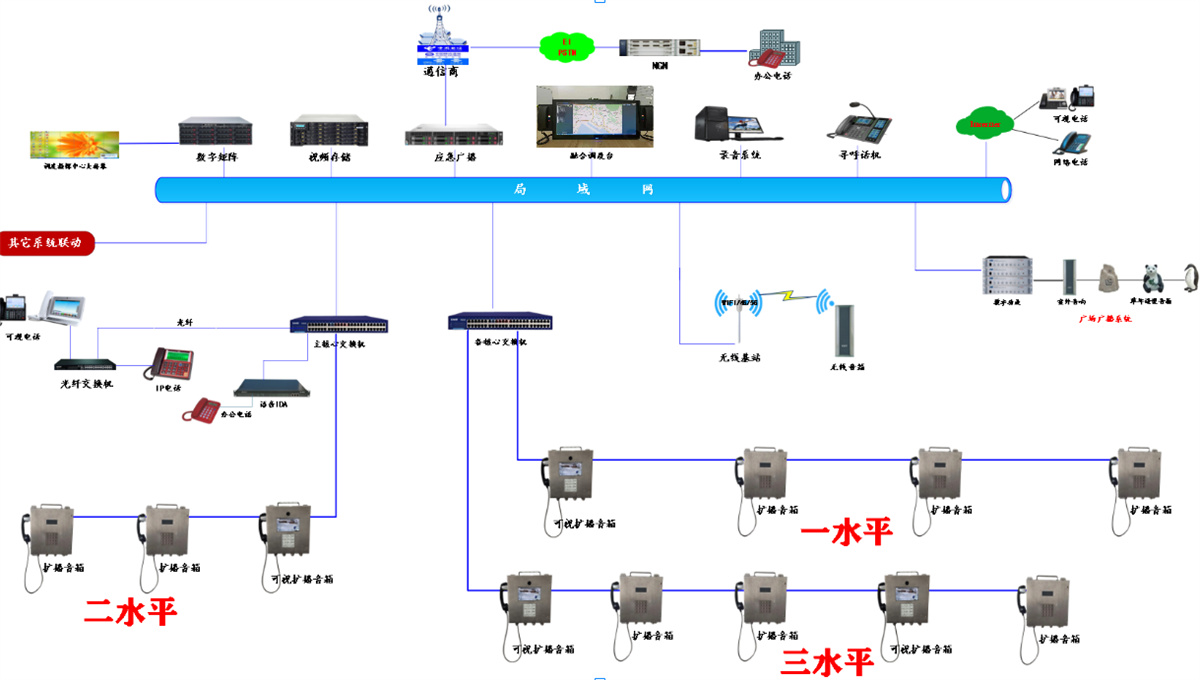
3.2 Based on industrial Ethernet transmission
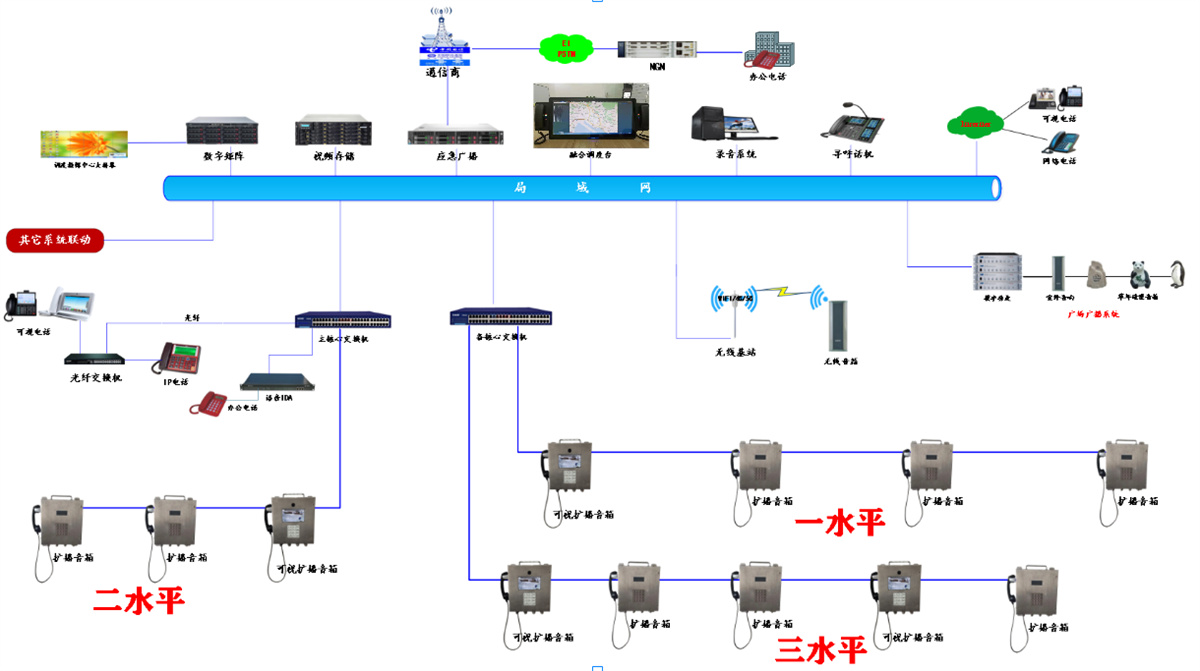
3.3 Integrated communication methods
The integrated communication method refers to the integration of wired telephone, wireless communication, and emergency broadcasting through the industrial ring network registered with the integrated communication server of the intrinsically safe mining broadcasting speaker, achieving unified scheduling and
command.
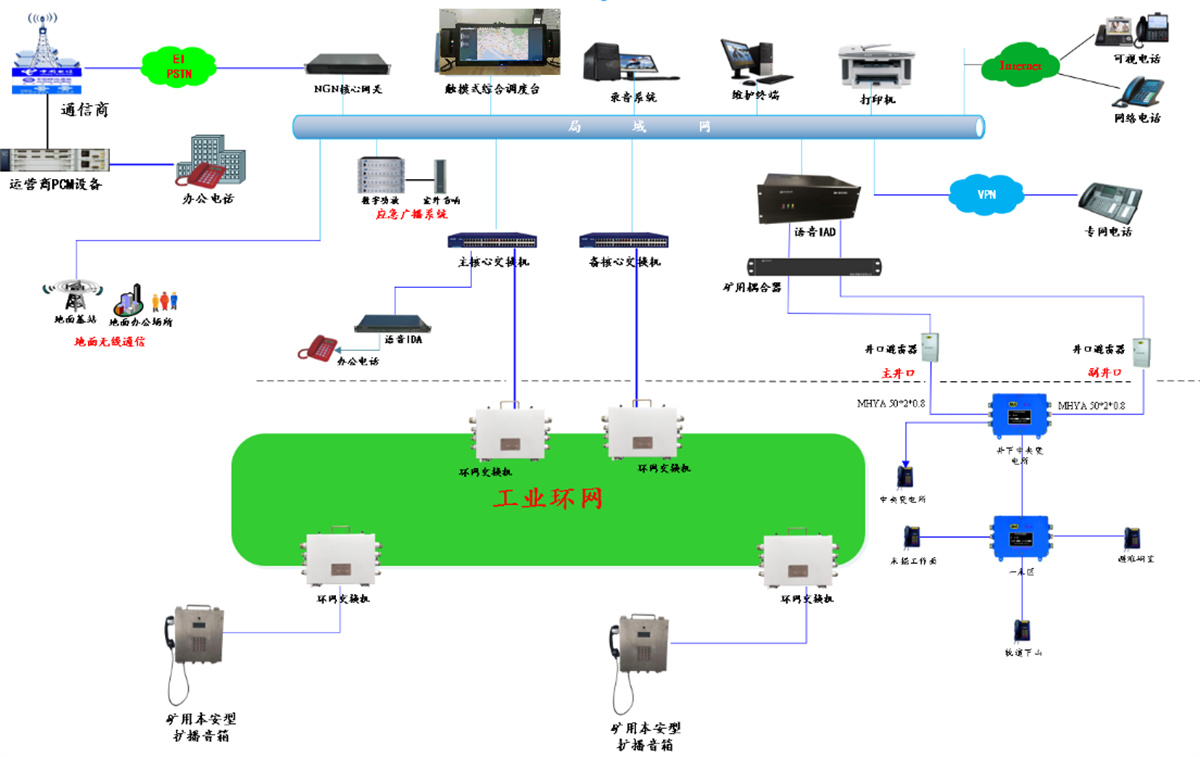
4.Main functions
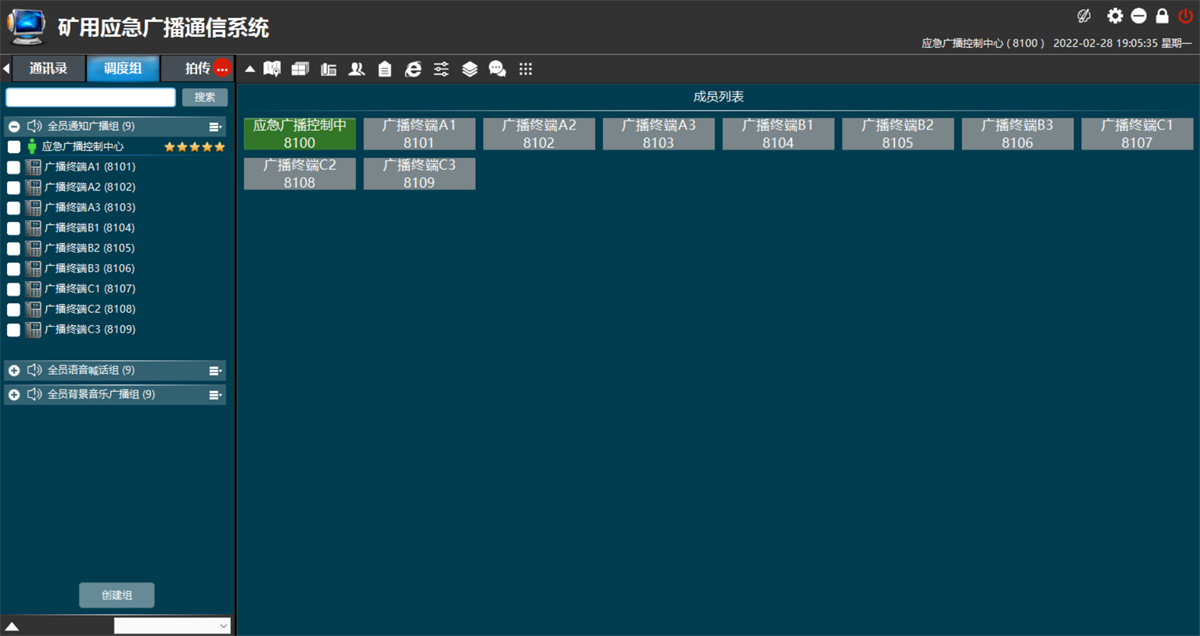
4.1. Call
(1) Bidirectional hands-free call: After the call is answered, immediately use hands-free communication, broadcasting, etc., suitable for use in places with very high noise levels.
(2) Bidirectional off hook call: Off hook call, once connected, immediately calls, full duplex with echo cancellation function.
(3) Bidirectional visual call: supports one-way or two-way visual call, and audio and video synchronization transmission.
4.2. Multi party calls
(1) Conference mode: Supports multi-party communication with up to 32 terminals (full duplex, hands-free with echo cancellation), and the conference can be interrupted by high priority intercom calls. The conference will resume after the intercom ends.
(2) Command mode: Supports multi-party communication with up to 32 terminals (full duplex, hands-free with echo cancellation), and command can be interrupted by high priority intercom calls. Command will resume after the intercom ends.
(3) Response mode: Supports up to 64 terminals in response mode for multi-party communication (full duplex).
4.3. Call
(1) Single click call: Quickly call to the designated target terminal, and each terminal can independently set the call target.
(2) Number key dialing call: By dialing with number keys, you can call any target terminal.
(3) Group call: Different levels, district teams, and application scenarios can set up different groups (or groups). By using the group calling button on the speaker, the system can call a set group (or group) with just one click, and automatically call a batch of terminals.
4.4. Call response
(1) Automatic answering: The called terminal can be set to automatically switch to call mode after ringing 0-9 times.
(2) Manual answer: The called terminal rings continuously until the manual button or handle responds.
4.5. Partition broadcasting

Different regions, levels, and units can be set as different groups (or groups), and different groups (or groups) can be divided into different zones. Different broadcasting methods can be set through different zones, such as different zones and scheduled broadcasting content; Different partitions have different broadcast content, etc. The dispatch station or paging telephone can broadcast calls and calls to terminals in single or multiple zones.
4.6. Monitoring
The terminal is equipped with a built-in microphone, which can monitor the sound situation around the terminal in the main control room.
4.7. Background music
The terminal speaker can play background music.
4.8. External control
The alarm output port of the terminal can control the alarm lights or door locks; Alarm input port, can be externally connected with a red emergency button.
4.9. Digital recording
The system automatically records digital recordings of two-way and multi-party calls, and the recording files are stored in the server‘s hard drive.
4.10. Scheduling function
Equipped with conventional scheduling functions, such as calling, group calling, forced insertion, forced dismantling, monitoring, answering, blind forwarding, negotiation forwarding, recording, hotline scheduling, conference, broadcasting, and other functions.
4.11. Interconnection and interoperability with other systems
The emergency broadcasting communication system supports digital relay interfaces, loop relay interfaces, SIP relay interfaces, etc., and can be interconnected with dispatch communication systems, wireless communication systems, local operators, etc.
4.12. Video linkage
The emergency broadcasting and communication system terminal has a linked nearby video monitoring function, which can link the video monitoring camera while calling and answering calls, achieving the purpose of video monitoring and video calling.
4.13. Linkage with other systems
The emergency broadcasting communication system can be linked with the mine safety monitoring system, environmental monitoring system, precise positioning system, video monitoring system, and other systems to achieve, for example, when the mine gas exceeds the limit or toxic and harmful gas exceeds the limit, the emergency broadcasting communication system can achieve linkage with the safety monitoring system, environmental monitoring system, precise positioning system, video monitoring system for safety warning and broadcasting. (Develop and connect based on the actual needs of the owner and the existing system)
4.14. Network management function
(1) Network diagnosis function: automatic topology, automatic detection and self-healing of ring network faults;
(2) Automatic discovery function;
(3) Remote configuration function;
(4) Remote software upgrade.
5. Main technical parameters of the product
5.1 System server
5.1.1. Electrical parameters
(1) Power supply and power consumption: 100-220V, AC: ≤ 65W;
(2) Working temperature and humidity: -10~60 ° C, ≤ 90% (non condensing)
(3) Processor and memory: high-performance dual core, 4G
(4) Hard disk: 1T
(5) Interface: 2 standard RJ45 (10/100/1000Base-T), 1 RS232 interface, and 2 USB 2.0 interfaces
(6) Size: rack mounted, 1U
(7) Network protocols: ARP, IP, ICMP, TCP, UDP, SIP
(8) Voice coding: G.722 (broadband), G.711a, G.711u, AMR
(9) Supporting protocols: RFC3261, RFC3262, RFC3263, RFC3264, RFC1889, RFC1890
5.1.2. System performance
(1) Terminal registration capacity: 100
(2) Number of concurrent calls: 100
(3) Concurrent recording channels: 100
5.1.3. Main functions:
(1) Intercom function: two-way call, video call, one click help, call recording
(2) Scheduling functions: forced insertion, forced disassembly, call monitoring, multi-party meetings
(3) Broadcasting functions: zone broadcasting, call out broadcasting, scheduled broadcasting, music broadcasting, text broadcasting
(4) Video function: Video linkage
(5) Telephone functions: incoming and outgoing calls
(6) Alarm function: triggering alarms and alarm plans
5.2 SM-KS101 Video Telephone Set
SM-KS101 is a visual large screen paging station product developed specifically for industry user needs, equipped with a gooseneck microphone and supporting high-definition hands-free calls. Based on the Android 9.0 system, it can support the installation and use of third-party Android applications, with a convenient interface. Adopting a 10.1-inch color touch screen, with built-in Bluetooth 5.0 module and 2.4G/5G Wi Fi module, and integrated USB 2.0 interface. Compatible with standard SIP protocol, it can be used as a monitoring center and leadership office management host, and can make calls, two-way intercoms, monitor/monitor, and broadcast calls to hosts and extensions within the management area. SM-KS101 can maximize the efficiency of daily business management and emergency response capabilities for enterprises.

5.2.1. Basic functions
1) 20 SIP lines
2) High definition voice
3) Support video calls
4) 10.1-inch 1280x800 color touch screen
5) Handle/Handsfree/Headphone Mode
6) Intelligent DSS keys (virtual buttons, touch)
7) Android OS 9.0
8) Built in applications: Explorer, calendar, camera, gallery, web browser, email, calculator, notepad, recorder, clock, video player, music.
9) Interface: Built in Bluetooth 5.0 module and 2.4G/5G Wi Fi module, with integrated USB 2.0 interface
5.2.2. Main technical parameters
1) Power supply: 5V/2A or PoE
2) 10/100/1000Mbps Ethernet (Bridge Mode)
3) Video decoding: H.264/H.265 (Optional)
4) Video call resolution: CIF/VGA/4CIF/720P/1080P
5) Protocol: SIP2.0 over UDP/TCP/TLS
6) Narrowband encoding: G.711a/u, G.729AB, iLBC
7) Broadband encoding: G.722, Opus
8) Working temperature: 0-45 ℃
9) Relative humidity: 10-95%
10) Installation method: desktop style
5.3 Technical indicators of intrinsically safe mining broadcasting speakers
1. Power supply voltage: DC12V~24V
2. Remote transmission of power supply: ≥ 500 meters
3. Network interface: 10/100Base-T, RJ-45
4. Network protocols: TCP/IP, UDP, ARP, ICMP, IGMP, SIP
5. Audio encoding: PCM, MP3, voice G.729, G.722, G.726
6. Echo cancellation: Supports G.168, maximum 96ms
7. Output volume: 10W,
8. Sound: not less than 110dB
9. Shell strength: Designed with stainless steel, resistant to impact and compression;
10. Protection design: IP67, can be immersed in water;
11. Installation method: Wall mounted.
5.4 Technical specifications of intrinsically safe visual broadcasting speakers for mining use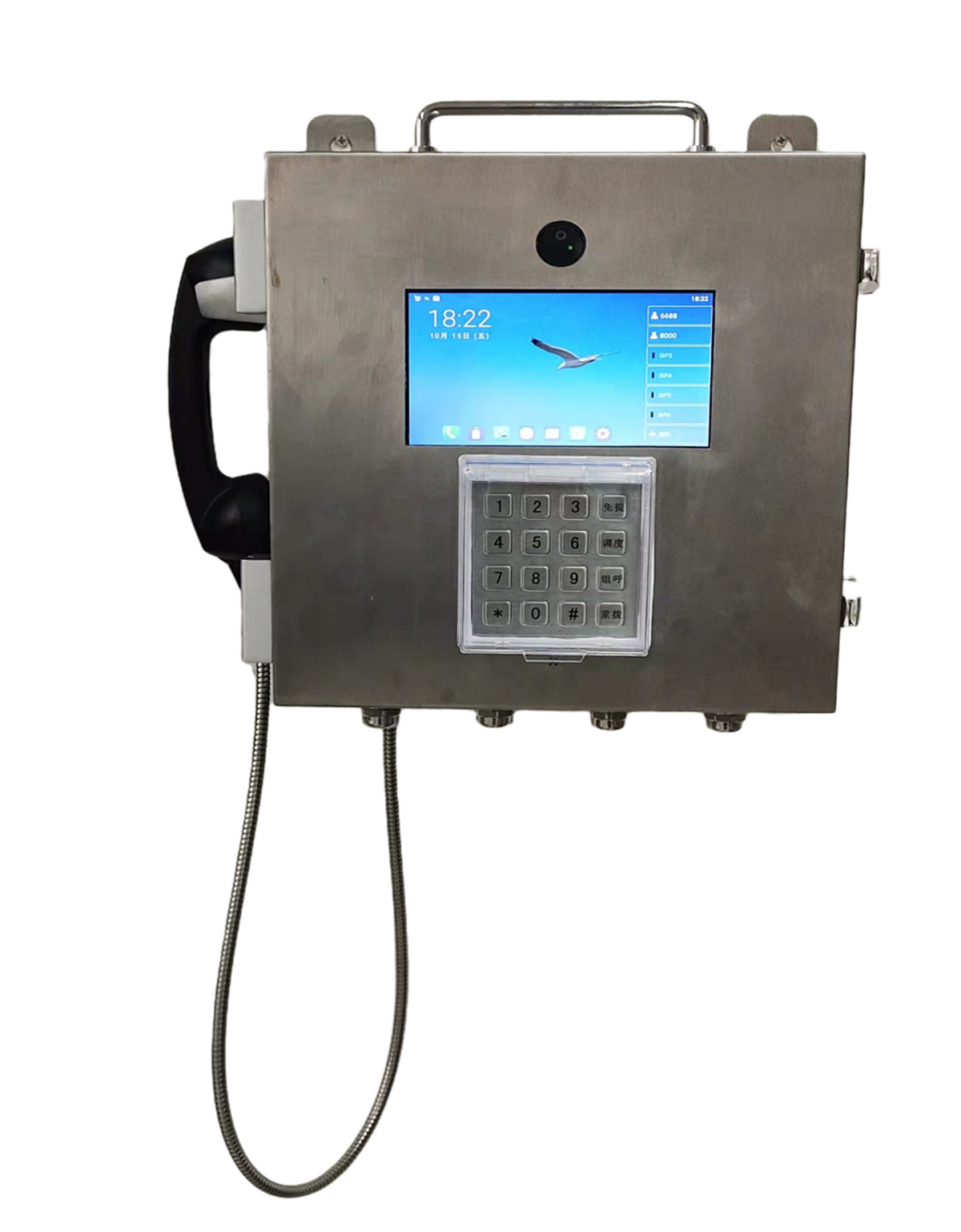

1). Explosion proof type: Mining intrinsic safety type
2). Working voltage: DC12V~24V
3). Remote transmission of power supply: ≥ 200 meters
4). Communication protocol: SIP v1 (RFC2543), SIP 2.0 (RFC-3261)
5). Encoding and decoding: G.729AB, G.711A/U, iLBC, G.722, Opus
6). Music output power: 10W
7). Sound: not less than 110dB
8). Gigabit optical port: 2 single-mode dual fibers
9). 100Mbps electrical port: quantity: 2 channels (intrinsic safe output);
5.5 KDW660/18B Mining Explosion proof and Intrinsic Safety Power Supply
1). Explosion proof type: Explosion proof and intrinsic safety type
2). Waterproof level: IP54
3). Input voltage: AC127V/380V/660V
4). Rated output voltage: Intrinsically safe DC 12V, output current: 1300mA; Intrinsically safe DC 18V, output current: 850mA
5). Protection method: dual overvoltage and overcurrent protection
6). Backup power function: The backup time is not less than 2 hours


 scan
scan
 158-1865-4305
158-1865-4305
 Room 439, Building 51, Qiongyu Road, Yuehai Street, Nanshan District, Shenzhen City, Guangdong Province
Room 439, Building 51, Qiongyu Road, Yuehai Street, Nanshan District, Shenzhen City, Guangdong Province